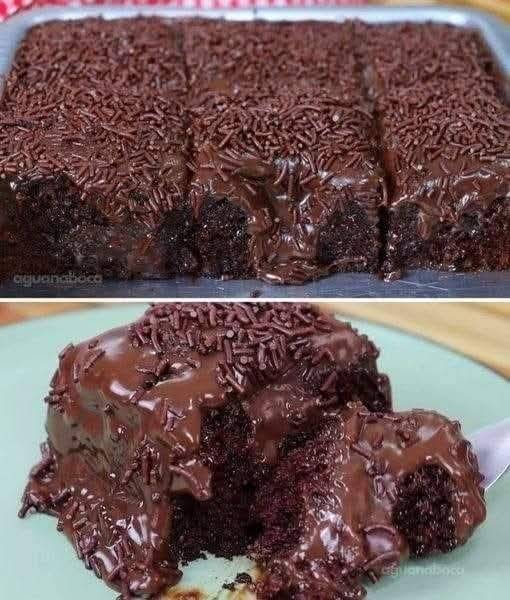ADVERTISEMENT
**Very Wet Chocolate Cake That Melts in Your Mouth: A Decadent, Moist, and Irresistible Treat**
When it comes to desserts, few things are as universally adored as a rich, moist chocolate cake. The mere thought of a decadent slice of cake that’s not only intensely chocolatey but also so moist that it melts in your mouth is enough to make anyone’s mouth water. The texture of a chocolate cake plays an important role in making it stand out – it’s not just about flavor, but the softness, the juiciness, and the way it just seems to dissolve with every bite. And when we talk about a “very wet” chocolate cake, we’re referring to a cake that is irresistibly moist, bursting with flavor, and leaves a lingering sense of indulgence with every mouthful.
If you’ve ever made a chocolate cake that was dry or lacked that mouth-melting quality, you’ll know how important it is to find the right recipe and techniques to achieve the perfect moistness. In this article, we’ll walk you through the details of crafting a “very wet” chocolate cake, including tips, tricks, and everything you need to make a cake that’s simply irresistible.
### **The Secret to a Wet Chocolate Cake: What Makes It So Moist?**
A truly “wet” chocolate cake is one that balances the right combination of ingredients, moisture, and technique. But what exactly makes a chocolate cake melt in your mouth? Let’s take a closer look at some of the key factors that make a cake moist and melt-in-your-mouth perfect.
#### **1. Ingredients Matter: Butter, Oil, and Buttermilk**
The right combination of fat and liquid is crucial in creating a cake that stays moist. Many chocolate cake recipes rely on butter for flavor, but oil is often the secret to creating a moist texture. Oil is liquid at room temperature, which keeps the cake moist for longer. When combined with other ingredients, oil provides a soft, tender crumb.
Buttermilk, another key ingredient, plays a dual role. First, it reacts with baking soda to help the cake rise, and second, it adds tangy moisture to the batter, contributing to its overall wetness. It also helps to tenderize the cake, ensuring that every bite is light, soft, and melt-in-your-mouth delicious.
#### **2. Using the Right Flour: All-Purpose Flour vs. Cake Flour**
When making a moist chocolate cake, the choice of flour is another important factor. Most recipes call for all-purpose flour, but cake flour is often used in premium recipes to produce a finer, lighter texture. Cake flour has less protein than all-purpose flour, which means it forms less gluten when mixed into the batter. This results in a finer, more tender crumb that adds to the overall moistness.
However, if you don’t have cake flour on hand, you can always substitute it with a blend of all-purpose flour and cornstarch. For every cup of all-purpose flour, remove two tablespoons of the flour and replace it with cornstarch. This simple substitution creates a lighter flour mixture that mimics the effects of cake flour.
#### **3. The Role of Sugar: Moisture Retention**
While sugar’s primary role in cake recipes is to provide sweetness, it also plays a critical role in keeping the cake moist. Sugar attracts and retains moisture, which prevents the cake from drying out during baking. In some “very wet” chocolate cake recipes, the amount of sugar used may be higher than in a standard cake to ensure that the cake remains moist throughout.
In addition, some cakes benefit from a combination of granulated sugar and brown sugar. Brown sugar contains molasses, which adds both moisture and a subtle caramel flavor that enhances the overall depth of the cake’s taste.
#### **4. Adding a Special Ingredient: Coffee or Cocoa Powder**
For a deep, rich chocolate flavor that elevates the overall taste of the cake, many recipes incorporate coffee or strong brewed espresso. While this might sound unusual, the coffee brings out the rich flavors of the cocoa powder and intensifies the chocolate taste without making the cake taste like coffee.
Alternatively, you can opt for Dutch-processed cocoa powder, which has a smoother, less acidic flavor than regular cocoa powder. This type of cocoa provides a rich, velvety texture that complements the moisture of the cake and ensures that each bite is packed with deep, indulgent chocolate flavor.
#### **5. Baking Techniques: Overmixing Can Ruin Moisture**
The way you mix the cake batter can also have an impact on how moist and tender your chocolate cake will be. Overmixing the batter after adding the dry ingredients can cause the cake to be dense, as the excess gluten formation leads to a tougher texture. To avoid this, mix the dry and wet ingredients just until they are combined. It’s important to resist the urge to overwork the batter, as this could lead to a heavy, dry cake rather than one that is light, fluffy, and moist.
Additionally, don’t forget that some moisture comes from the air. The humidity in your kitchen, especially on rainy or humid days, can affect how much moisture is in your batter, so be mindful of the climate when baking.
For Complete Cooking STEPS Please Head On Over To Next Page Or Open button (>) and don’t forget to SHARE with your Facebook friends
